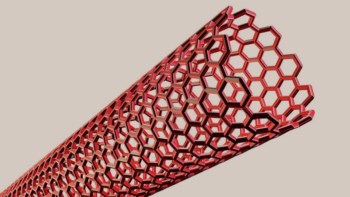
Atomically thin graphene drumheads can vibrate at very high temperatures of over 900°C, which is the highest operating temperature ever reported for such electromechanical resonators. The structures could be used to make nanoelectromechanical systems (NEMS) for a variety of sensing, signal processing and communications applications that would work in harsh or extreme environments.
Graphene drums are made of 2D sheets of carbon that resonate at a certain frequency. In this new work, by Philip Feng and colleagues at Case Western University in Cleveland, Ohio, they are only one to three atomic layers thick with a diameter of between 3 and 5 microns.
The researchers made their devices using a simple dry-transfer technique to align and deposit these atomic layers onto pre-patterned microcavities on semiconductor chips. They also dry-transferred thick and highly conductive graphite flakes to act as bridging interconnects between the atomic-layer graphene and lithographically patterned metal electrodes on the chips. These electrodes make for high-quality electrical contacts, important for subsequently electrothermally tuning the devices.
Operating temperature as high as silicon carbide devices
Feng’s team made the graphene membranes resonate by applying an AC voltage and heated them up by applying a DC bias voltage. This electrothermal technique increases the temperature of the membranes via Joule heating.
“The membranes can vibrate at temperatures of over 900°C (which is the temperature at which graphene can be synthesised in a furnace by chemical vapour deposition),” explains Feng. “This is the highest operating temperature ever reported for an electromechanical resonator and is comparable to that recorded for silicon carbide electronic devices (800–900°), made by researchers at NASA’s Glenn Research Center.”
Negative thermal expansion coefficient
According to the researchers, such high-temperature resonance comes from the fact that graphene has a negative thermal expansion coefficient. This means that the material shrinks when heated, unlike conventional materials that expand.
“As well as this unusual property, it also has an exceptionally high thermal conductivity (comparable to that of diamond, which is the best thermally conductive solid known),” Feng tells nanotechweb.org. “The material can be strained by up to 25% of its original surface area too before it fractures, which also helps.”
And that is not all: the resonator’s quality factors also significantly increase with temperature.
“Our work shows that graphene resonators could be used to make electrically tuneable, voltage-controlled nanoscale electromechanical oscillators,” says Feng. “Applications include sensors and transducers that would work at very high temperatures and in harsh or extreme environments.”
The devices are detailed in Nano Letters DOI: 10.1021/acs.nanolett.7b04685.



